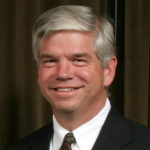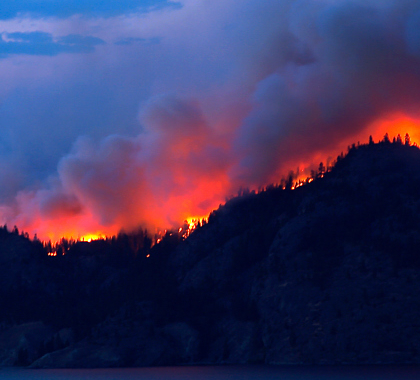What if someone said they planned to burn down your house, for your own good? Suppose they claimed they needed to study how houses burn so they could build better computer models to predict future home fires.
Asinine as this sounds, that is precisely what the U.S. Forest Service (USFS) has decided to do, starting in Utah, then Georgia, New Mexico, and South Carolina, as part of an incredible scheme called the Fire and Smoke Model Evaluation Experiment. The agency said it needs to study the behavior of giant, fast-moving forest fires, so it concocted an elaborate plan to set several fires on purpose.
The first “large, high-intensity prescribed crown fire” targeted the Fishlake National Forest in Utah, a spectacular area home to the state’s largest natural mountain lake and numerous reservoirs that supply surrounding communities and farms.
Once famous for its unparalleled stands of aspen trees and wide variety of wildlife, the forest has fallen into a state of unhealthy overgrowth and dead trees, like most national forests. In June, USFS torched more than 2,000 acres near Manning Creek, with about 40 scientists watching, filming, sampling soil, flying drones, testing air quality, and collecting data on the amount of “fuel” consumed and the behavior of fire and smoke.
Plenty of Natural Fires
I could have saved them a lot of time and money. The fire burned thousands of trees, killed and displaced hundreds of birds and animals, destroyed the soil for many years, and created a massive amount of air pollution, all perfectly predictable results, things already well-understood from the numerous other such “test” fires USFS set previously.
In fact, this plan to “study” massive fires might have a shred of credibility if there had been no opportunity to study disastrous wildfires before, but the agency has seen more than 100 million acres of forests burn over the past 20 years, while doing virtually nothing to reduce the fuel loads or thin the forests to a more natural condition. There are volumes of studies about these catastrophic fires and the massive loss of resources, wildlife, property, and lives they have caused. Several agencies, including USFS, host websites on the subject and have published numerous studies discussing them.
Dare we wonder if there is such a thing as “settled science,” a time to stop studying and start acting?
Burning Forests to Study Climate
Officials now claim they need to study the effects of these fires on climate change and vice versa.
In doing so, they will release untold tons of carbon dioxide into the air, instead of growing healthy trees that absorb it. In 2019 alone, California fires released 68 million tons of carbon dioxide. The “expected outcomes” of this bizarre research scheme include “improved scientific knowledge of the physically coupled fuels–fire–smoke–chemistry system.” Do forest scientists really not understand the chemistry of smoke?
Another stated goal is to create “exportable methodologies for measuring fuels for fire spread, fuel consumption, and fire emissions models.” Translation: bureaucrats and academics want to build better computer models.
Forests need better management, not better computer models. Voltaire once wrote, “Men argue; nature acts.” It is an apt description of how our generation has squandered the greatest legacy of the conservation movement: our national forests.
Human-Caused ‘Wildfires’
Devastating fires are constantly in the news, but a crucial fact rarely mentioned is these fires are not natural. They are caused by mismanagement and no management. Our generation has virtually stopped the professional management of public forests, and forests, people, and wildlife are paying the appalling price. We are witnessing the disease, death, rotting, collapse, and burning of billions of trees covering millions of acres of previously healthy forests.
Centuries of nature’s uncomfortable balance are easily upset when people and cities move in. So our job is to mimic the role of nature, to maintain the most “natural” conditions possible. We are failing miserably.
Nature previously kept the growth of forests in check with periodic fires, sparked by lightning. Natural fires burn the brush, grasses, saplings, and small trees so the forest does not grow too dense, mostly leaving older and larger trees undamaged.
After Americans began to settle the West, dependent as they were on the forests for wood, they viewed forest fires as crises. Preventing and extinguishing fires were a primary goal of forest management for a century. Nonetheless, national forests still were not overly dense, because the natural role of fire was replaced by continual thinning of the forests. Forests were logged to provide lumber, recreation, healthy watersheds, species protection, and fire prevention.
In recent decades, with environmental scolds preaching the sermon of “let nature take its course,” logging fell out of favor. Timber sales were all but eliminated in national forests and were completely eliminated in national parks and wilderness areas. Logging on federal lands plummeted by 84 percent since the 1980s. That management tool was replaced with nothing.
‘Unnatural Overgrowth’
The resulting unnatural overgrowth created tinderbox conditions that, when ignited, obliterate the entire landscape in ways that are well-documented and -understood. Yet, political leaders continue to argue while nature, left to its own devices, burns to the ground.
The Utah fire “experiment” is an unconscionable waste of valuable forest resources, pollution of the air, and destruction of habitat. Torching a forest in Utah to add a few more data points will not address any of the major problems confronting our national forests that a return to sound, active forest management might.
Greg Walcher ([email protected]) is natural resource consultant and the author of Smoking Them Out: The Theft of the Environment, and How to Take it Back.





